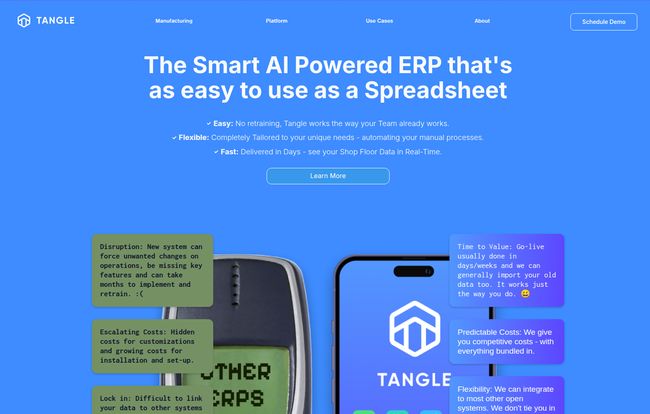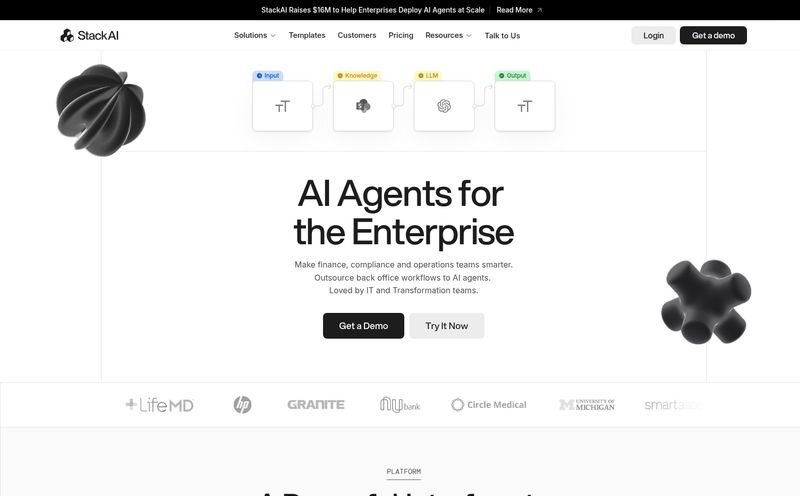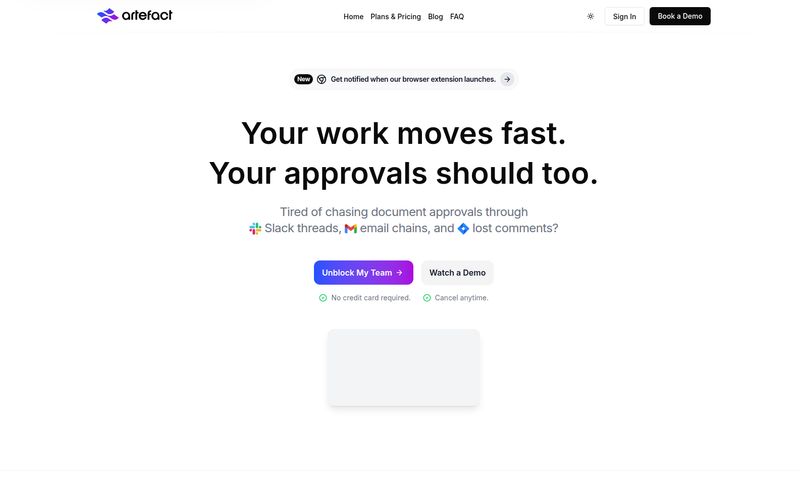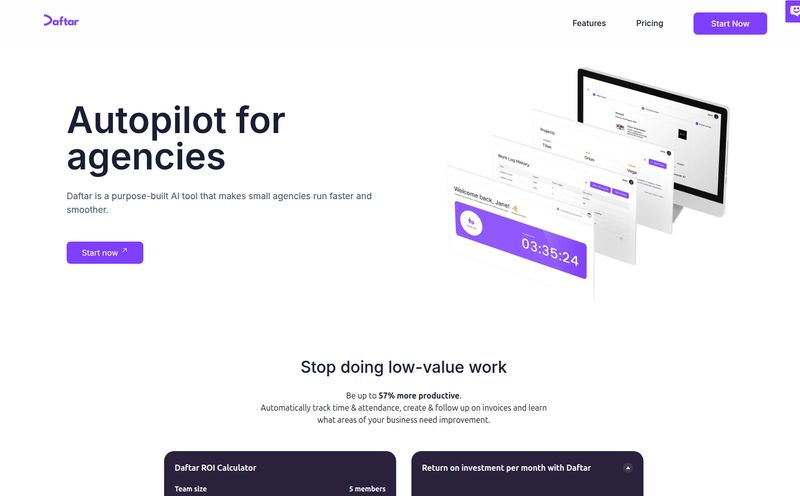I’ve been in the SEO and business growth world for a long time, and if there’s one thing that gives me a nervous twitch, it’s the term 'ERP implementation'. For most manufacturers, those words conjure images of budget overruns, six-month training programs, and software so clunky it feels like you're trying to send an email on a Texas Instruments calculator. We've all been there, right? Staring at a gray, soul-crushing interface, wondering if it would just be easier to go back to using spreadsheets.
In fact, for years, that’s been the great divide: the raw power of an Enterprise Resource Planning system versus the simple, beautiful flexibility of a good old spreadsheet. You either got control or you got usability. You rarely got both.
So when I stumbled upon Tangle, their tagline hit me like a ton of bricks: “The Smart AI Powered ERP that’s as easy to use as a spreadsheet.”
Bold claim. A very, very bold claim. But after digging in, I have to say… they might actually be onto something.
The Clunky Old Guard of Manufacturing ERPs
Let’s be real for a second. Traditional ERPs were built for a different era. They’re monolithic beasts, designed with a one-size-fits-all philosophy that fits absolutely no one perfectly. They demand you change your unique, finely-tuned processes to fit their rigid workflows. It's like buying an expensive suit and then being told you need to have surgery to fit into it. It’s backwards.
This often leads to what I call “Software Resentment,” where your team actively avoids using the very tool that’s supposed to make their lives easier. They keep secret spreadsheets on the side just to get their work done, and your expensive ERP becomes little more than a glorified, out-of-date database. Sound familiar?

Visit Tangle
So What is Tangle, Really?
Tangle is positioning itself not just as an alternative, but as a completely new way of thinking about manufacturing management. It's a smart ERP built specifically for the chaos and complexity of modern manufacturing. Instead of a rigid block of code, think of it more like a set of high-tech LEGOs.
It's built on a low-code platform, which is a fancy way of saying it can be customized and adapted incredibly quickly without needing a team of dedicated software developers. They provide a set of powerful, pre-built components for things like inventory, scheduling, and quoting. Then, you can use their no-code tools to snap those pieces together in a way that perfectly mirrors your actual workflow. Not the other way around.
And because it's infused with AI, it doesn't just store your data; it helps you make sense of it. It’s designed to spot bottlenecks, predict inventory needs and optimize production schedules on the fly. This is the future, folks.
A Look at the Tools in Tangle's Toolbox
Okay, let's get into the nitty-gritty. What can this thing actually do? I’ve seen a lot of platforms promise the world, but Tangle’s feature set seems incredibly practical and focused on the areas that cause the most headaches for manufacturers.
Getting a Real-Time Grip on Your Shop Floor
This is the big one. Tangle offers real-time shop floor data collection, job tracking, and time tracking. The days of walking around with a clipboard to see a job's status are over. This real-time visibility means you can make smarter decisions, faster. You can see which machine is down, how far along a critical order is, and where your team is spending their time. The scheduling module helps you orchestrate this complex dance, ensuring jobs flow smoothly through production without costly delays.
From Quoting Chaos to Cash in Hand
How long does it take your team to put together an accurate quote? If the answer is “too long,” you’re leaving money on the table. Tangle’s Quote-to-Cash system is designed to streamline this entire process. By integrating with customer management and production costing, it helps you generate accurate quotes quickly. According to their own data, clients see a 20% increase in quoting and purchasing efficiency. That's not just a time-saver; it’s a competitive advantage.
Making Sense of Your Stock and Spend
Inventory is a tricky balancing act. Too much, and you're tying up cash. Too little, and you're shutting down the production line. Tangle’s Inventory Management and Production & Costing Management modules work together to give you clarity. They claim users see a 27% increase in inventory accuracy, which is huge. Knowing exactly what you have, what it costs, and when you need more is fundamental to profitability.
The Results Speak Louder Than Marketing Copy
I'm a data guy. I love a good story, but I trust numbers more. And Tangle puts their numbers front and center.
- 30% increase in production efficiency
- 20% decrease in production costs
- 90% of companies that try Tangle, end up buying it
That last one is the real kicker. A 90% trial-to-buy rate is almost unheard of. It tells me that once people get their hands on it, they see the value immediately. The testimonials echo this. A guy named John mentioned, “Other Vendors could not meet our requirements or our aggressive timeline,” which points to Tangle's flexibility and rapid deployment. Another review from Dhimo praised how Tangle was able to “bend and be as flexible as we needed it to be.” This isn't the language people use for traditional ERPs, believe me.
Okay, So What's the Catch? Let's Talk Pricing.
If you've clicked over to their pricing page, you've already noticed: there are no prices. It’s a “contact us for a demo” situation. Now, my inner cynic usually screams and runs for the hills when I see this. But in the world of custom enterprise software, it actually makes sense.
Tangle isn't selling a one-size-fits-all product off the shelf. They're selling a tailored solution. The cost will depend on the size of your operation, the specific modules you need, the level of customization, and the number of users. Listing a single price would be misleading. They emphasize “predictable costs,” which suggests a bundled, transparent approach rather than nickle-and-diming you for every little change. It’s a different model, one that values a custom fit over a sticker price. So while its a bit of a pain not seeing a number, I get it.
Potential Roadblocks and How Tangle Seems to Address Them
No tool is perfect, and implementing any new system comes with risks. It’s only fair to look at the potential downsides. But I was impressed to see Tangle seems to have thought these through.
- Fear of Disruption? They focus on rapid deployment and a system so intuitive that it requires “no retraining.” If they can deliver on that, it dramatically lowers the barrier to switching.
- Worried about Hidden Costs? Their whole model seems to be based on predictable, bundled pricing, a direct counter-argument to the classic ERP money pit.
- Risk of Vendor Lock-In? They highlight flexibility and “Tangle Connectors,” showing they're built to integrate with other systems, not trap you in their ecosystem.
- Bad Vendor Support? They explicitly state they want to be an “extension of your team,” which is a far cry from the faceless support tickets many of us are used to.
Frequently Asked Questions about Tangle
Is Tangle only for huge manufacturing companies?
Not necessarily. While it's powerful enough for large enterprises, its low-code flexibility and modular approach could make it a great fit for small to medium-sized manufacturers who have outgrown spreadsheets but are scared of traditional ERP costs and complexity.
Do I need a team of developers to use Tangle?
This is the beauty of the low-code/no-code approach. For most customizations and day-to-day use, you shouldn't need a developer. The idea is to empower your own team—the people who actually know your processes—to configure the system themselves. For deep integrations or brand new functionality, you might need some technical help, but the dependency is drastically reduced.
How does Tangle connect with my accounting software like QuickBooks?
This is what their “Tangle Connectors” are for. They are designed to build bridges between Tangle and other critical software you use, whether it’s for accounting, shipping, or something else. You'd need to confirm specifics for your stack during a demo.
How long does it take to get up and running?
While every implementation is different, Tangle's entire value proposition is built on speed. They talk about building apps in “hours,” not months. Compared to the 6-18 month rollouts of traditional ERPs, the timeline is likely to be significantly shorter.
Why do I have to contact them for pricing?
Because they are creating a solution tailored to your specific business needs. The price is based on the components you use, your number of users, and the complexity of your operation. It’s a custom quote for a custom solution, which ultimately is fairer than a flat fee for features you might not even use.
My Final Verdict on Tangle
I’ve seen a lot of software that claims to be revolutionary. Most of it isn’t. But Tangle feels different. It’s not just a new coat of paint on an old idea; it’s a fundamental rethinking of how manufacturing software should work.
By combining the flexibility of low-code platforms with the power of AI and a deep understanding of manufacturing workflows, they’ve created something that could genuinely bridge the gap between clunky, powerful ERPs and simple, flexible spreadsheets. It offers the control of the former with the usability of the latter.
If you're a manufacturer who is tired of fighting with your software, drowning in spreadsheets, or afraid of the traditional ERP monster, I think you owe it to yourself to at least schedule a demo with Tangle. It might just be the breath of fresh air your shop floor has been waiting for.
Reference and Sources
- All information and statistics were sourced directly from the official Tangle Software website.
- For more on the evolution of enterprise software, see this article on low-code development from Forbes.



